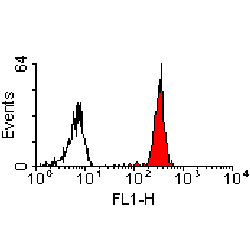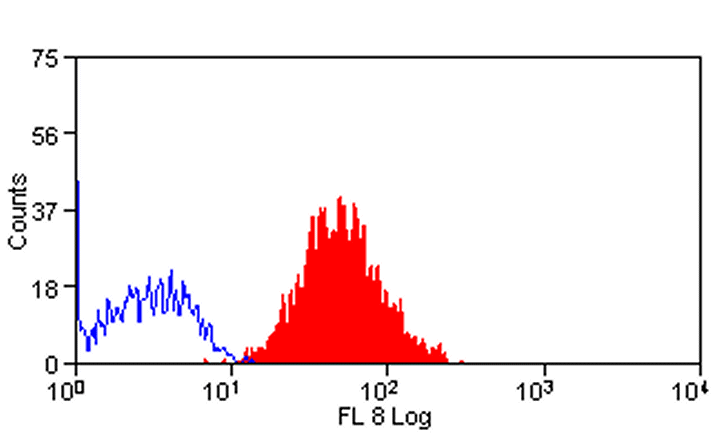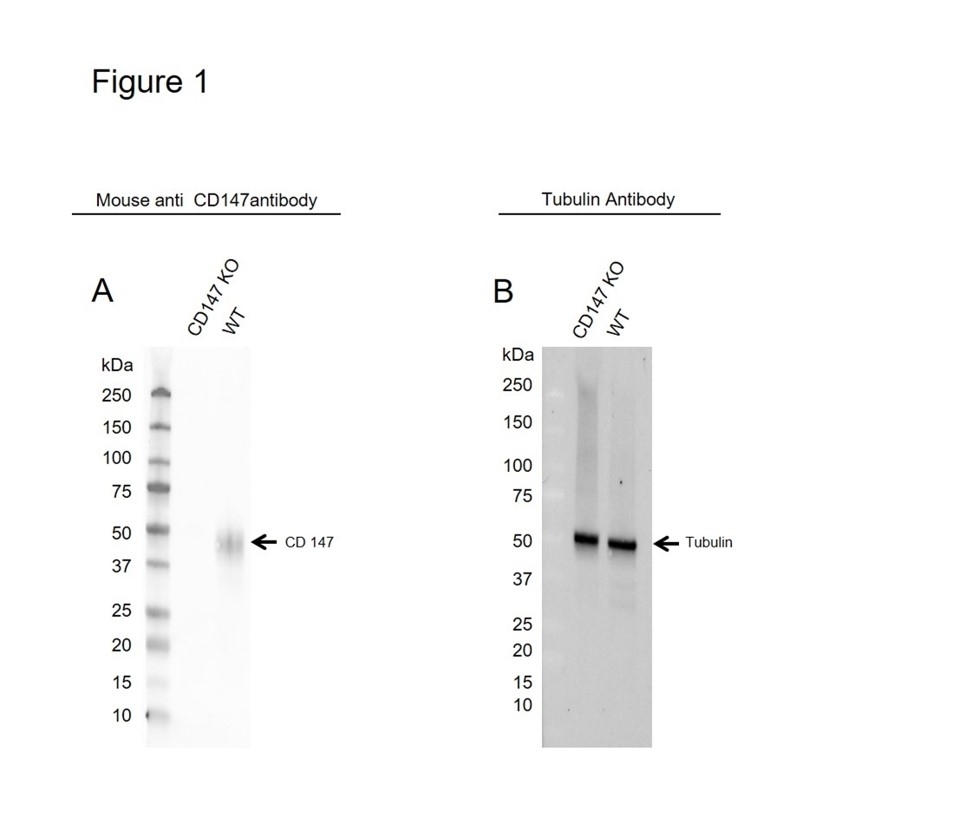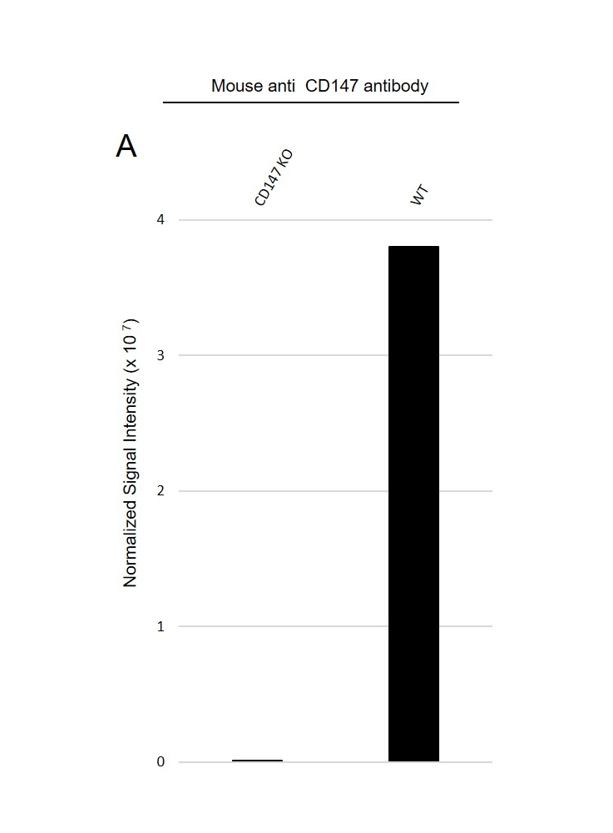CD147 antibody | MEM-M6/1





Mouse anti Human CD147
- Product Type
- Monoclonal Antibody
- Clone
- MEM-M6/1
- Isotype
- IgG1
- Format
- Purified
- Specificity
- CD147
| Mouse anti Human CD147 antibody, clone MEM-M6/1 recognizes the human CD147 cell surface antigen, also known as Basigin, EMMPRIN and collagenase stimulatory factor. CD147 is a 385 amino acid single pass type 1 trans-membrane glycoprotein bearing 3 potential N-glycosylation sites, a single N-terminal (distal) Ig-like C2-type domain amd a more proximal Ig-like V-type domain in its extracellular region. Mouse anti Human CD147 antibody, clone MEM-M6/1 was raised and screened against recombinant extracellular region of huCD147 expressed in CHO cells, along with a number of other MEM-M6 clones. Epitope mapping indicates that clone MEM-M6/1 binds to an epitope within the distal Ig-like C-2 type domain. This is confirmed by flow cytometry using beads coated with constructs containing only the distal Ig-like or proximal Ig-like domains (Koch et al. 1999). Mouse anti Human CD147 antibody, clone MEM-M6/1 binds to both un-stimulated and phytohemagglutinin (PHA) stimulated (activated) T lymphocytes with levels of CD147 enhanced following PHA stimulation. CD147 is also expressed by peripheral blood and endothelial cells as well as many cultured cells of hematopoietic and non-hematopoietic origin (Koch et al. 1999). In addition to clone MEM-M6/1 we are also able to offer the MEM-M6/6 clone derived from the same fusion which recognizes an epitope in the membrane proximal Ig-like V type domain and has inhibitory effects on CD3 induced T cell activation ( |

|
- Target Species
- Human
- Product Form
- Purified IgG - liquid
- Preparation
- Purified IgG prepared by Protein A affinity chromatography from tissue culture supernatant
- Buffer Solution
- Phosphate buffered saline
- Preservative Stabilisers
- 0.09% sodium azide (NaN3)
- Immunogen
- CD147Rg, consisting of the cDNA coding for the extracellular region of human CD147.
- Approx. Protein Concentrations
- IgG concentration 1 mg/ml
- Fusion Partners
- Spleen cells from immunized Balb/c mice were fused with SP2/0 mouse myeloma cells.
- Regulatory
- For research purposes only
- Guarantee
- 12 months from date of despatch
- Acknowledgements
- PrecisionAb is a trademark of Bio-Rad Laboratories
Avoid repeated freezing and thawing as this may denature the antibody. Storage in frost-free freezers is not recommended.
| Application Name | Verified | Min Dilution | Max Dilution |
|---|---|---|---|
| Flow Cytometry | 1/50 | 1/100 | |
| Immunoprecipitation | |||
| Western Blotting 1 |
- 1MEM-M6/1 recognizes CD147 under non-reducing conditions.
- Flow Cytometry
- Use 10μl of the suggested working dilution to label 106 cells or 100μl whole blood
| Description | Product Code | Applications | Pack Size | List Price | Your Price | Quantity | |
|---|---|---|---|---|---|---|---|
| Mouse IgG1 Negative Control | MCA928 | F | 100 Tests |
|
Log in | ||
| List Price | Your Price | ||||||
|
|
Log in | ||||||
| Description | Mouse IgG1 Negative Control | ||||||
Source Reference
-
Koch, C. et al. (1999) T cell activation-associated epitopes of CD147 in regulation of the T cell response, and their definition by antibody affinity and antigen density.
Int Immunol. 11 (5): 777-86.
References for CD147 antibody
-
Schneiderhan, W. et al. (2007) Pancreatic stellate cells are an important source of MMP-2 in human pancreatic cancer and accelerate tumor progression in a murine xenograft model and CAM assay.
J Cell Sci. 120: 512-9. -
Yang, Y. et al. (2008) Cyclophilin A up-regulates MMP-9 expression and adhesion of monocytes/macrophages via CD147 signalling pathway in rheumatoid arthritis.
Rheumatology (Oxford). 47: 1299-310. -
Schneiderhan, W. et al. (2009) CD147 silencing inhibits lactate transport and reduces malignant potential of pancreatic cancer cells in in vivo and in vitro models
Gut. 58: 1391-8. -
Chen, Y. et al. (2009) Upregulation of HAb18G/CD147 in activated human umbilical vein endothelial cells enhances the angiogenesis.
Cancer Lett. 278: 113-21. -
Hu, J. et al. (2010) Involvement of HAb18G/CD147 in T cell activation and immunological synapse formation.
J Cell Mol Med. 14 (8): 2132-43. -
Huang, Z. et al. (2013) Overexpression of CD147 contributes to the chemoresistance of head and neck squamous cell carcinoma cells.
J Oral Pathol Med. 42: 541-6. -
Bernard, S.C. et al. (2014) Pathogenic Neisseria meningitidis utilizes CD147 for vascular colonization.
Nat Med. 20 (7): 725-31. -
Nassif, X. et al. (2015) Cd147 as receptor for pilus-mediated adhesion of meningococci to vascular endothelia.
Patent Publication number US20150110806 A1
View The Latest Product References
-
Trakarnsanga, K. et al. (2017) An immortalized adult human erythroid line facilitates sustainable and scalable generation of functional red cells.
Nat Commun. 8: 14750.
- Synonyms
- Neurothelin
- RRID
- AB_322225
- UniProt
- P35613
- Entrez Gene
- BSG
- GO Terms
- GO:0000139 Golgi membrane
- GO:0005515 protein binding
- GO:0007596 blood coagulation
- GO:0016021 integral to membrane
- GO:0005537 mannose binding
- GO:0006090 pyruvate metabolic process
- GO:0007166 cell surface receptor linked signaling pathway
- GO:0015129 lactate transmembrane transporter activity
- GO:0042470 melanosome
- View More GO Terms
- GO:0050900 leukocyte migration
MCA1876
If you cannot find the batch/lot you are looking for please contact our technical support team for assistance.
Please Note: All Products are "FOR RESEARCH PURPOSES ONLY"
View all Anti-Human ProductsAlways be the first to know.
When we launch new products and resources to help you achieve more in the lab.
Yes, sign me up



